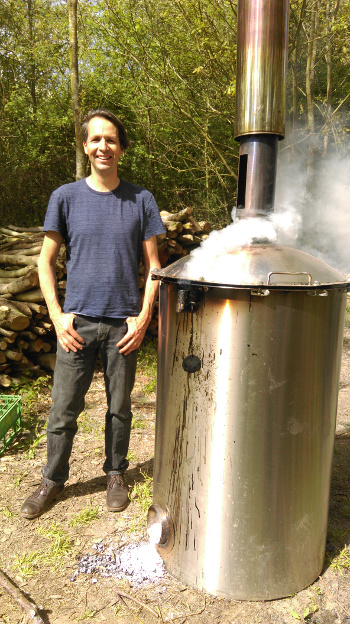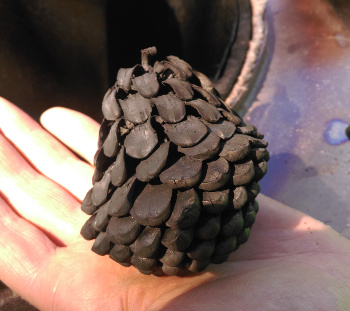
James Hookway and his retort in Bottoms’ Corner
We’ve bought a charcoal retort. And that’s exciting. After months of deliberation, long conversations with all sorts of people, attendance at shows and demos and general procrastination, we’ve plumped for one of James Hookway’s stainless steel beauties.
Having decided to give charcoal a go, I had a bash with very small and then much bigger ring kilns. During 2017 we adapted several oil drums to turn them into kilns, but it didn’t take long to work out that using a ring kiln wasn’t something we wanted to do in the long-term. Not a difficult decision really on a practical level – kilns are inefficient (using a large proportion of stock wood to fuel the charring process) and unbelievably smoky. Admittedly, a large proportion of the smoke is water vapour, so perhaps not quite as bad for the atmosphere as they at first appear. The clincher was the practicality of operating a ring kiln. Unloading is dirty! Shovelling kicks up the dust and that stuff’s black. It gets into the places you don’t want dust.
Anyway, the alternative (assuming earth burns aren’t your thing) is a retort. Having studied all of the models of retort we know to be on the market in the UK at present, most are too big and too expensive for a new venture run by timid entrepreneurs! We may dream of something bigger but, having chosen the smallest on the market, we are still suffering wallet burn – it wasn’t at all cheap.
James Hookway has spent several years developing his retort. I initially acquired plans for his and a couple of others, thinking I’d get one built. I know nothing about making metal things, so spoke to a couple of local likely lads, whose initial confidence slipped away once they understood something of what was required. A retort operates at high temperatures – apparently up to 600-700 degrees Celsius – and depends on sealed chambers staying sealed. At those kind of temperatures, metal moves around, so this isn’t a project for the faint-hearted.

A pine cone after charring
The retort process is fairly simple. A fire, fuelled by very small diameter waste wood (of which we produce mountains each winter), heats up the wood to be charred until it releases volatile, flammable compounds. Rather than being lost into the atmosphere, these gasses are diverted back into the fire and continue to fuel the process, burning efficiently and cleanly, to leave close to 100% of the initial charge to convert to charcoal. Very little smoke is produced as most is burned in the very hot exhaust. It’s not new technology – the Victorians were using them – but James’ version uses stainless steel throughout, lots of insulation and a rather clever ‘rocket stove‘. Although we’ve experienced some teething problems, his service has so far been excellent.
The charcoal produced is something to behold too; it’s rather beautiful. Some of it has a surface iridescence of blue, gold and silver and the most amazing ring when tapped. These combined with its lightness are sure signs of a quality, high-carbon charcoal. Because retort charcoal is harder, it’s less dusty than that produced in a kiln. The retort can be emptied easily as it can be tilted and the charcoal raked out into buckets.
Time will tell how the retort stands up to a few summers of hard use, for that’s how it needs to be operated to pay for itself.
More information about Hookway Retorts
